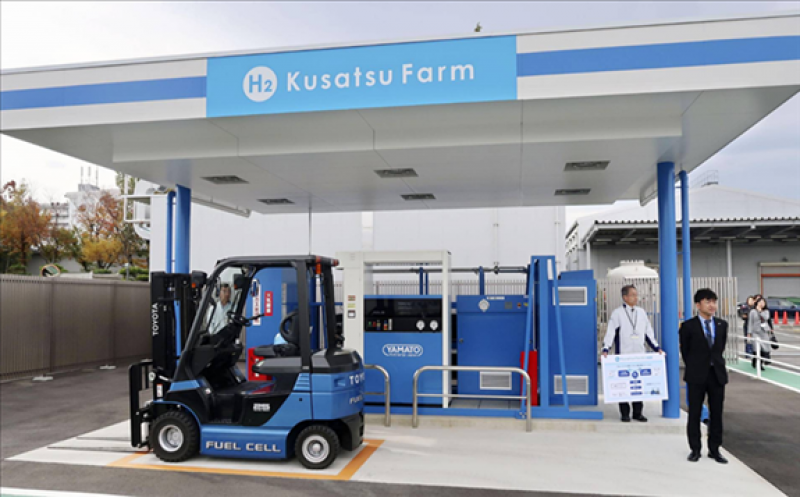Panasonic Corp. is turning a fuel-cell factory in the lakeside city of Kusatsu, in Shiga Prefecture, into what could be the world’s first hydrogen-based plant powered entirely by renewable energy.

Prime Minister Yoshihide Suga’s October pledge to make Japan carbon-neutral has been a “tailwind” for Panasonic’s hydrogen-factory project, and the company intends to commercialize the system by fiscal 2023 and sell it globally, said Norihiko Kawamura, manager of Panasonic’s hydrogen business promotion office.
Japan was an early leader in developing hydrogen as an alternative to fossil fuels. The country began investing heavily in the gas in the 1970s when the first of several oil shocks exposed its reliance on imported petroleum.
But in recent decades, the efforts of Japan and other countries to exploit the energy source slowed. Despite growing investment, the cost of producing hydrogen has remained stubbornly high, discouraging investment in the infrastructure and technologies needed to make the fuel more widely adopted.
“What’s different today is that cost isn’t the only factor at play,” Kawamura said in an interview at the Kusatsu site. National carbon pledges and targets of major customers such as Apple Inc., which aims to make its supply chain carbon-neutral by 2030, are tipping the balance. The number of inquiries the company received about its factory solution spiked following Suga’s announcement, he said.
Suga sparked a flurry of activity on hydrogen in Japan from other companies, too, that are keen to meet emissions limits and make money from the technology. Eighty miles east of Kusatsu, in Aichi prefecture, hydrogen-powered Mirai cars roll off the lines of a Toyota Motor Corp. plant, while a hydrogen charging station hums and clicks as it refuels over a hundred forklifts with the gas.
In December, Toyota banded together with hydrogen producer Iwatani Corp., Sumitomo Mitsui Financial Group Inc. and other companies to promote the build-out of supply chains and technologies. Toyota later announced that it plans to sell modular fuel-cell systems for buses, trains, ships and generators, to “strengthen its initiatives as a fuel-cell system supplier.”
Home hydrogen
In the push to reduce emissions, many manufacturers have fitted factories with solar panels that charge batteries to produce power. But the solution is weather dependent, making it insufficient for many heavy electricity users that need guaranteed energy.
Panasonic’s plant, which makes fuel-cells for homes and condos, would be powered using a mix of solar panels and lithium-ion storage batteries together with bigger fuel cells that convert hydrogen into electricity.
The company plans to market the commercial hydrogen system in Japan, China and Europe, and expects to earn around ¥300 billion ($2.7 billion) in sales in 2030.
Still, technological challenges remain to make the fuel competitive with rival energy sources, such as liquefied natural gas and batteries.
So-called green hydrogen, made with renewable energy, costs between $2.50 and $4.50 a kilogram and that price is unlikely to fall to the $1 a kilogram it takes to make the gas using fossil fuels before 2030, according to BloombergNEF.
Costs can be even higher in Japan, which may have to ship green hydrogen from countries with cheaper solar power, such as Australia and Saudi Arabia.
Japan’s advantage as an early adopter is also being eroded as other nations jump on the hydrogen bandwagon.
“Nearly everything” from the number of countries creating hydrogen strategies to production of electrolyzers is on track to double this year, according to BNEF. By 2022, shipments of electrolyzers, the systems that break water into hydrogen and oxygen using electricity, are set to quadruple, with China as the biggest and cheapest manufacturer.
Europe aims to increase its renewable hydrogen production sixfold by 2024, and last year unveiled a plan to channel hundreds of billions of euros into hydrogen investment. The French government has earmarked €7 billion ($8.2 billion) this decade to support green hydrogen development, while Germany announced an even larger €9 billion plan as part of its green recovery efforts.
Government support
Takaya Imai, a special adviser to the Cabinet on energy and former aide to the previous prime minister, Shinzo Abe, said in a recent interview that Japan’s hydrogen industry development would need more financial backing from the government for the country to remain a leader in the field.
Last year the government allocated ¥2 trillion for investment in green technologies such as fuel cells and batteries to help meet its 2050 goal. Imai said funding for decarbonization should be as much as ¥3 trillion a year, to support efforts like the construction of infrastructure and to help small and medium-sized manufacturers bear the cost of switching to hydrogen.
Panasonic’s Chief Executive Officer Yuki Kusumi said in an interview earlier this year that he’d like to see units that contribute to the environment — such as fuel-cell systems and electric vehicle batteries that the company provides to Tesla Inc. — become a core growth area for the company.
It’s a long road, and Kawamura said the company will spend the next two years testing ways of procuring hydrogen and suppressing generation costs.
“This is challenging and won’t immediately bring returns,” Kawamura said. “It’s an investment in the future.”